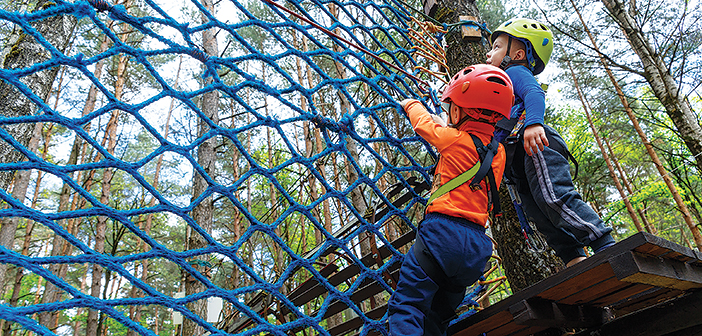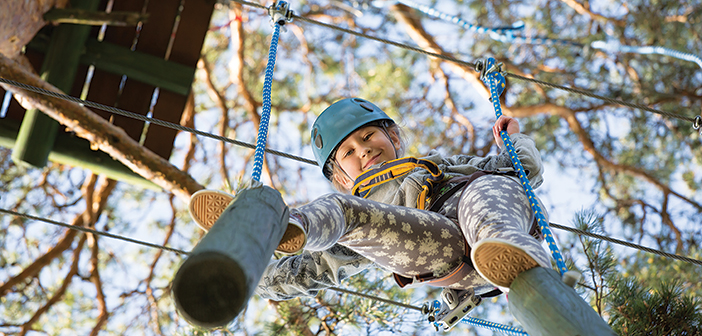If your business operations include welcoming and working with children, you must be diligent and step up your standard of care. Working with kids requires special efforts.
For perspective, my comments here are coming through the lens of an insurance person. If you work with children, you should discuss the issues below with your attorney, the manufacturer of your course, and your equipment providers. My hope is to reinforce the notion that working with children will require you to take extra steps to keep them from harm’s way.
From a legal standpoint, there are three types of persons that might be on your premises: trespassers, invitees, and licensees. You have a legal duty of care, at varying levels, for each of these. Negligence is the legal term used when a duty of care is breached and results in bodily injury to a third party.
When you have a business and invite the public onto your premises for your benefit, they are considered invitees. Still, it’s important to understand the three classifications of visitors to your property, and the duty of care you owe to each.
Three Types of Guests
Trespassers are people on another’s property for their own purpose, without the property owner’s permission. The law does not place upon the property owner much duty of care for trespassers. With a few exceptions, the owner owes the trespasser nothing.
Since there is no legal duty to use care, the failure of the owner to provide care is not negligence. The chain of consideration necessary for negligence—legal duty to use care, failure to do so, resulting injury or damage, and so forth—is broken at the first step.
Traps and kids. There are two exceptions, though: the property owner may not deliberately set a trap, and a property owner owes a duty to protect small children who may not understand that they are trespassing. This second exception rests on the principle that all members of society owe a duty to children to protect them from harm.
Much of the law involving minors is based on the idea that children must be protected from themselves, from actions that children do not realize will harm them. Property owners owe a duty to small children to keep them safe, even when these children are trespassing.
This duty applies when something exists that the landowner knows will attract children. The attraction, aka attractive nuisance, is something from which children must be protected, because they might be injured by it.
Licensees are people on another’s premises for their own benefit, and who can be assumed to have implied permission. Licensees include door-to-door salesman, meter readers, delivery people, police, firemen, etc. The landowner owes reasonable care to a licensee. Reasonable care would require the removal of hazards where appropriate, or the posting of signs warning of these hazards in cases where their removal is not appropriate.
Invitees are people on the property for the mutual benefit of the invitee and the property owner. An invitee is owed greater than ordinary care. The landowner should actively seek out hazards and remove them. If this is not possible, care should be taken to post signs warning of these hazards. There should be indications of some positive, affirmative action to protect the invitee—action to indicate that care was taken.
Kids are special. For invitees that are children of tender age, you owe the highest degree of care possible. Tender age is typically defined as 12 years old or younger. However, some jurisdictions may define the age younger.
Who determines what is the highest degree of care and if you are providing it? Well, if you have ever had a lawsuit against you, you find out really quickly that the jury panel ultimately makes that determination.
Navigating the Standards of Care
In the 1980s and ’90s, during the early years of this industry, ropes courses were used predominantly for team building and self-esteem at summer camps and schools. Many of the participants were children of tender years, and camps/schools were required to provide the highest degree of care. They had to make sure they built their courses to the accepted standard at the time, hired third-party training companies, submitted to third party inspections, etc.
At that time, ACCT had the only applicable standard, and as a result, many camp insurers required compliance with ACCT. Now there are several standards related to this industry. Which one provides the highest degree of care for children? Compare the standards and hold your operation to the one that requires a higher level of care for children.
Sexual abuse prevention. Camp insurance carriers also require that their camp clients hire qualified staff, run criminal background checks, and check the sex offender database. At nearly all businesses where staff works with children, sexual abuse prevention training is a requirement, especially now that the Protecting Young Victims from Sexual Abuse and Safe Sports Authorization Act of 2017 was passed at the federal level. Are you familiar with the mandatory reporting requirements for which you now have a legal obligation?
Designed for kids? Most zip line tours were not built to accommodate children, per se. The lines are tuned by weight range, not the age of participants. When a zip tour operator asks, “What is the minimum age for someone to ride a zip line?” I typically refer them back to the manufacturer. The most common response refers to the weight range.

Aerial adventure parks are designed differently in that weight, while important, is not the driving factor. Creating challenging aerial obstacles for various levels of ability seems to be the goal. Many installations have courses designed for children, while others will be for the more capable patron. Did your builders design the course with children in mind, since children are often an important target market?
Waivers can be waived. Often in lawsuits involving a child, the waiver signed by the parents, waiving their rights, does not apply to the rights of the child. So, depending on your jurisdiction, once that child is of legal age, he or she may be able to file a lawsuit against you.
We have had several incidents involving children over the years, and often the insurance company will seek a court-approved settlement, as opposed to settling with the parents out of court. This typically bars the child from filing suit once he or she turns legal age. The carrier may pay out a little more than you think is necessary, but that’s in an effort to insulate you from future litigation on the same incident.
Kid Considerations
If you have children on your course, ask yourself these questions:
• What is the highest degree of care, and am I providing it? The best way to know is to compare with others in the industry. If everyone is doing criminal background checks and you are not, that could be an issue.
• Can I provide evidence of my efforts to provide the highest degree of care?
• Do I comply with all state laws regarding youth recreation and amusements?
• Am I in compliance with the Protecting Young Victims from Sexual Abuse and Safe Sport Authorization Act of 2017?
• Do I provide specific staff training for staff members that work with children? How is that training different from my regular staff training? Does it address protection of the child while in your custody on the property?
• What are the manufacturer’s guidelines regarding use of its product? Did the manufacturer provide a minimum age or weight? Did I get a certificate of insurance to show the manufacturer has products liability and professional coverage for design?
• Are my harnesses designed for children?
• Is my orientation designed so that children understand it, or is it the same orientation provided to adult patrons?
In the event of a lawsuit, you will have to defend yourself. Work through these questions now rather than during a crisis. Re-evaluating how you prepare yourself, your staff, and your course for energetic young patrons will make your program stronger and will reduce your rate of incidents.

To sum it up, I recently took a call from a zip line operator who asked if it’s OK to put kids under age 5 on his zip tour that was built for adults. He made his case for how strong the system is, the safe working loads, etc. I told him I understood the math. Then I told him that when my son was 4, I could have put him on the gas tank of my motorcycle and rode around. He fit, but was that really a good idea? The operator replied, “Not really.” And that was the end of the conversation.



